Diplomatic Bluebook 2018
Chapter 4
Japan's Diplomacy Open to the Public
3 Cooperation with Local Government
Cooperation with local governments is one of the priority issues of the Cabinet. MOFA actively works on regional revitalization and strives to deploy measures that contribute to the vitalization of regions in order to strengthen comprehensive diplomatic capabilities through collaboration with regions.
In Japan, “Projects to Support Regional Revitalization” which started in 2015 using the Iikura Guest House, MOFA's facility, were jointly implemented with Saga Prefecture (February), Yamaguchi Prefecture (March), Fukuoka Prefecture (July) and Okayama Prefecture (August). Under this scheme the Foreign Minister and respective prefectural governors co-hosted seminars and receptions and invited ambassadors to Japan as well as foreign business communities to the Iikura Guest House in order to broadly disseminate the various attractiveness of regions to audiences both in Japan and abroad. With around 300 people in attendance, each project proved to be a success. The diplomatic corps in Japan and other participants developed interests in the co-hosting local governments, which provided an opportunity for the promotion of further exchanges and collaboration.
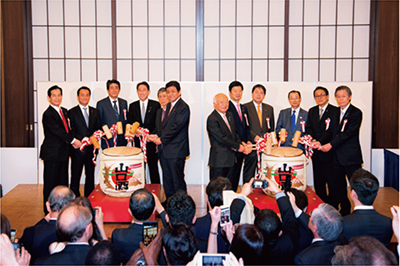 Kagami Biraki ceremony at a reception co-hosted with the Governor of Yamaguchi Prefecture (March 23, Tokyo, Iikura Guest House of Japan)
Kagami Biraki ceremony at a reception co-hosted with the Governor of Yamaguchi Prefecture (March 23, Tokyo, Iikura Guest House of Japan)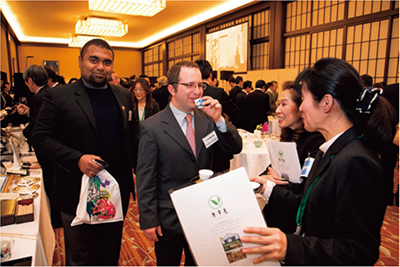 Booths set up for a reception co-hosted with the Governor of Saga Prefecture (February 1, Tokyo, Iikura Guest House of Japan)
Booths set up for a reception co-hosted with the Governor of Saga Prefecture (February 1, Tokyo, Iikura Guest House of Japan)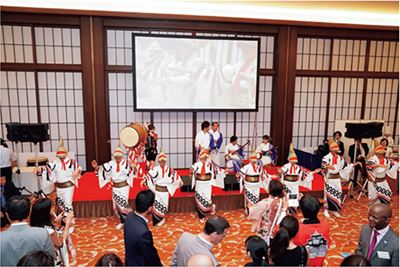 Stage performance at a reception co-hosted with the Governor of Okayama Prefecture (August 2, Tokyo, Iikura Guest House of Japan)
Stage performance at a reception co-hosted with the Governor of Okayama Prefecture (August 2, Tokyo, Iikura Guest House of Japan)In addition, in 2017, MOFA continued to implement the “Local to Global” project, which was initiated in 2016. In this project, the Foreign Minister and other high-level MOFA officials visit regions in Japan with the diplomatic corps in Japan to engage in dialogue with the local people, and promote the attractiveness of the regions to the world, with the aim of connecting Japan's regions with the world and further vitalizing such areas. Foreign Minister Kishida visited Okinawa Prefecture (February), Kumamoto and Fukuoka prefectures (March), Aomori and Hokkaido prefectures (April), Ishikawa Prefecture (June), and Kagawa and Hyogo prefectures (July). During these visits, Foreign Minister Kishida, together with ambassadors and other officials, exchanged views with prefectural governors and mayors while enjoying meals made with an assortment of local ingredients, visited local SMEs in the community with traditional technologies or cutting-edge technologies, and participated in community festivals and other events. Through these activities, participants were able to experience firsthand the attractiveness of Japan's regions and this diverse attractiveness was shared broadly with audiences inside and outside Japan.
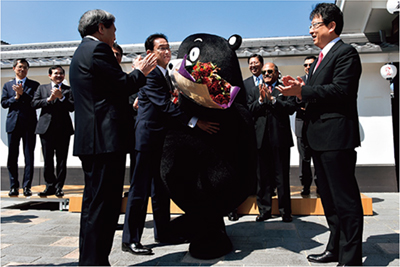 The 3rd “Local to Global” project: Foreign Minister and others being welcomed by Kumamon (March 12, Kumamoto City)
The 3rd “Local to Global” project: Foreign Minister and others being welcomed by Kumamon (March 12, Kumamoto City)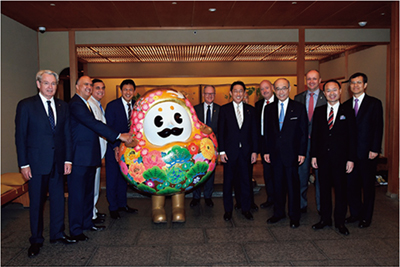 The 5th “Local to Global” project: Foreign Minister and others being welcomed by Hyakumansan (June 3, Kanazawa City, Ishikawa Prefecture)
The 5th “Local to Global” project: Foreign Minister and others being welcomed by Hyakumansan (June 3, Kanazawa City, Ishikawa Prefecture)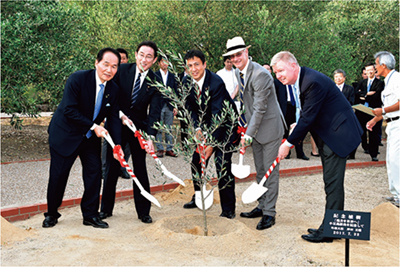 The 6th “Local to Global” project: Foreign Minister and others planting trees at Roadside Station Shodoshima Olive Park (July 22, Shodoshima Town, Kagawa Prefecture)
The 6th “Local to Global” project: Foreign Minister and others planting trees at Roadside Station Shodoshima Olive Park (July 22, Shodoshima Town, Kagawa Prefecture)Besides this, “Regional Promotion Seminars” were organized by several local governments for the diplomatic corps in Japan as an opportunity to further promote inbound tourism. These seminars featured presentations marketing the attractiveness of tourist destinations in each community and the benefits of investing in these regions. At the seminars, participating local governments set up booths for the diplomatic corps in Japan and other participants to showcase local specialty products and tourism. The seminars were highly praised by participating diplomatic corps and others as a valuable venue where they were able to experience firsthand the attractiveness of regions without leaving Tokyo.
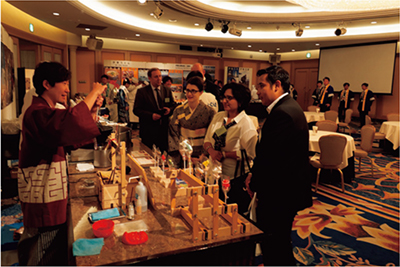 Regional Promotion Seminar: networking session (June 5, Tokyo)
Regional Promotion Seminar: networking session (June 5, Tokyo)“Diplomats' Study Tours” organized for the diplomatic corps in Japan were conducted in northern Akita Prefecture (May), Miyazaki Prefecture (July), Gunma Prefecture (September), and the Ise-Shima area of Mie Prefecture (November), with around 90 members of the diplomatic corps visiting each location. The diplomatic corps, including ambassadors, visited places of scenic beauty in each region as well as cultural and industrial facilities in the community, which enabled them to experience the many community attractions of each region. The tours resulted in some local governments launching exchanges and collaboration with participating countries while others aim to increase the number of visitors to their communities utilizing the connections with participating diplomatic corps, making the tours contributing to the vitalization of regions.
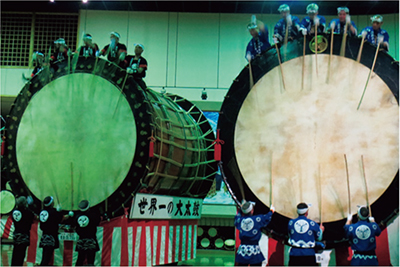 Diplomats' Study Tour: performance featuring the world's largest taiko drum (May 9, northern Akita Prefecture)
Diplomats' Study Tour: performance featuring the world's largest taiko drum (May 9, northern Akita Prefecture)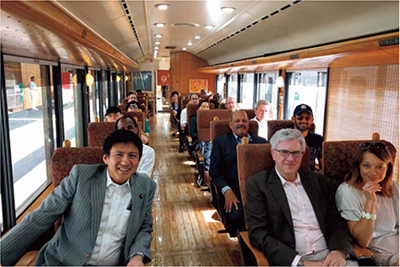 Diplomats' Study Tour: Parliamentary Vice-Minister for Foreign Affairs Shunsuke Takei participating in a tour with the diplomatic corps in Japan (July 14, Miyazaki Prefecture)
Diplomats' Study Tour: Parliamentary Vice-Minister for Foreign Affairs Shunsuke Takei participating in a tour with the diplomatic corps in Japan (July 14, Miyazaki Prefecture)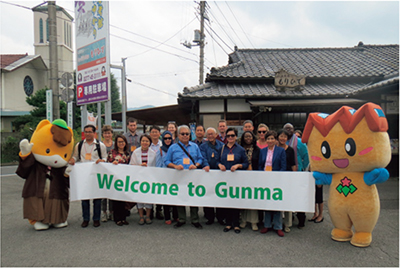 Diplomats' Study Tour: Diplomatic corps in Japan welcomed by mascot characters (September 27, Gunma Prefecture)
Diplomats' Study Tour: Diplomatic corps in Japan welcomed by mascot characters (September 27, Gunma Prefecture) Diplomats' Study Tour: at the inner sanctuary of Ise Grand Shrine (November 20, Ise-Shima area of Mie Prefecture)
Diplomats' Study Tour: at the inner sanctuary of Ise Grand Shrine (November 20, Ise-Shima area of Mie Prefecture)Furthermore, MOFA actively provides local governments with opportunities to explain Japan's current diplomatic policies and exchange views. As a part of such activities, a “Local Partnership Cooperation Forum” was held in January, which was attended by around 270 people comprising mainly local government officials. Part One of the forum was the foreign policy briefing session, which consisted of a presentation on recent Japan-China relations. In Part Two of the forum, which featured sectional meetings, participants exchanged views on the themes of “results of the sales channel expansion project of the Association for the Promotion of Traditional Craft Industries and future aspirations,” “initiatives to unearth overseas demand, open up overseas sales channels, and promote visits to Japan by foreign nationals using a worldwide sellers network and Japanese brand story selected for overseas buyers (B-to-B),” “promoting Japanese sake to the world to become a tourist destination country,” and “ways of harnessing 2020 for communities.”
Overseas, MOFA continued to conduct the comprehensive PR program called “Project to Support Overseas Presentations to Promote the Attractiveness of Regions” for sharing the attractiveness of regions, promoting exports of prefectural products and supporting tourism for regional revitalization together with efforts to eliminate and ease import and travel restrictions as a way to dispel damage from international rumors stemming from the Great East Japan Earthquake. This project was held in Beijing in February and Taipei (hosted by the Japan-Taiwan Exchange Association) in March.
At the PR event held in Beijing in February, with Hidetoshi Nakata, a former member of the Japanese national football team, in attendance as a special guest, Deputy Chief Cabinet Secretary Kotaro Nogami delivered an address at the opening ceremony. The event, which was attended by about 15,000 people over the two-day period, featured 16 local governments, including Miyagi Prefecture and Fukushima Prefecture. At the PR event held in Taipei, State Minister for Internal Affairs and Communications Akama delivered remarks at the opening ceremony. This event featuring 20 local governments, including Fukushima Prefecture and Chiba Prefecture, was attended by about 8,400 people during the two-day period.
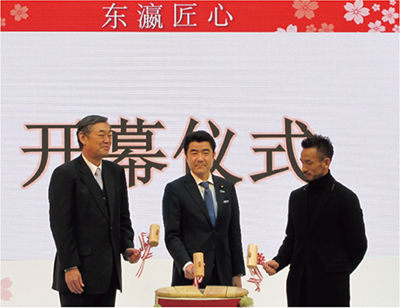 Project to Support Overseas Presentations to Promote Attractiveness of Regions (Beijing): Opening Ceremony (February 25)
Project to Support Overseas Presentations to Promote Attractiveness of Regions (Beijing): Opening Ceremony (February 25)In addition, a total of nine “Regional Promotion Projects” were conducted in Asia, North America, and Europe as measures to support local governments in promoting the development of local industries and regional economies through the attractiveness of each region by making use of Japan's diplomatic facilities overseas. For example, in Asia, the event “Charms of Yamanashi” was jointly held by Yamanashi Prefecture and the Embassy of Japan in Viet Nam in October, featuring presentations on the prefecture's tourism resources and its specialty products. During the post-event networking session, the attractiveness of Yamanashi was marketed with grapes and wine tasting, etc.
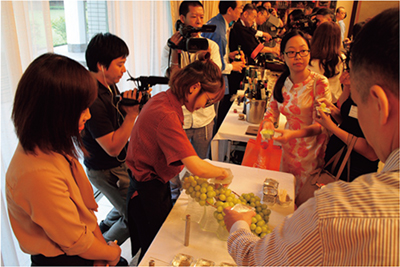 Regional Promotion Seminar: Booth showcasing prefectural products at the networking session (October 10, Viet Nam, Embassy of Japan in Viet Nam)
Regional Promotion Seminar: Booth showcasing prefectural products at the networking session (October 10, Viet Nam, Embassy of Japan in Viet Nam)In addition, MOFA fully supports sister-city exchanges between Japanese local bodies and their counterparts abroad through various initiatives. Specifically, in order to support the international initiatives of local governments and communities, Japanese diplomats visit sister cities of Japanese municipalities and share each other's opinions with officials responsible for international/economic exchanges. Also, heads of the diplomatic missions overseas visit local cities in Japan to have dialogues and deliver lectures on sister city exchanges prior to leaving for new posts or when they temporarily return to Japan. In addition, if a foreign local governmental body wants to establish a sister-city relationship with a Japanese one, MOFA indirectly supports such a move by providing prefectures and 20 major cities with relevant information and posting it on the “‘Glocal' (global and local) Diplomatic Network” on the website of MOFA2.
As part of the overseas promotion of alcoholic beverages (Japanese sake, wine, shochu, awamori, etc.) produced in various parts of Japan, diplomatic missions overseas actively promote alcoholic beverages produced in Japan, including Japanese sake, by carrying out proactive PR activities to showcase Japanese alcoholic beverages, by way of offering them at lunch/dinner with government leaders of the assigned countries or diplomatic corps of other countries, and making a toast with Japanese sake at grand events such as the Emperor's birthday receptions.
Moreover, MOFA works on supporting local SMEs (small and medium-sized enterprises). With the rapid economic development, the demand for water treatment, waste disposal, urban transportation, and anti-pollution measures, etc., have sharply increased in developing countries. In cooperation with Japanese local authorities and by making use of ODA, MOFA supports the overseas business expansion of local SMEs, which have accumulated knowledge on countermeasures against such problems, and increases development cooperation. This contributes not only to the global outreach of local companies, development of globally competent human resources, and Japanese style of infrastructure export but also to vitalizing the economy of the whole of Japan as well as some local areas.
- 2 Currently (as of February 2018), the countries with a large number of Japan's sister and partnership cities (including prefectures and municipalities) are, in descending order, the U.S. (451), China (363), the ROK (162), Australia (109), and Canada (71) and so on. (Calculated by the Council of Local Authorities for Internal Relations; see its website: http://www.clair.or.jp/j/exchange/shimai/countries/)
